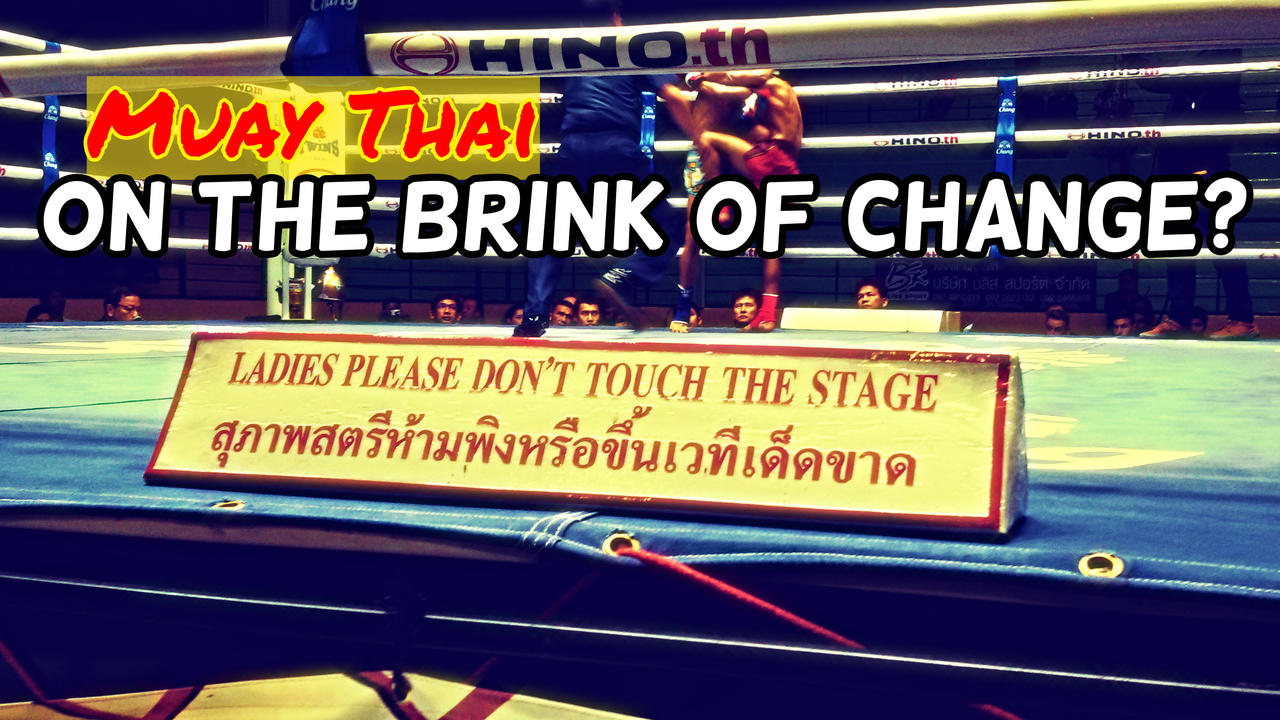Muay Thai & Women: On the Brink of Change

EXCLUSIVE INTERVIEW WITH THE FIRST GOVERNMENT CERTIFIED FEMALE MUAY THAI TRAINER IN THAILAND
From Muay Thai Guy
Nai Khanom Tom stepped into the ring. The Siamese prisoner knew what was on the line.
The Burmese King Mangra and all his subjects cast their eyes on the man. It had been seven years since the invasion in the Ayutthaya Kingdom and he was seized captive as one of many in the aftermath. There are few, if any, moments in prison for a man to feel honored or make an impact, but for Nai Khanom Tom, his time had come.
As a highly skilled and trained boxer, Nai Khanom Tom was selected to compete against the Burmese boxing champion, in a test to satisfy the king’s curiosity of how Muay Boran would stand against Burmese boxing. The pride of his people, of his master, of Siam, surged through his veins.
Nai Khanom Tom began with the ritual of the Wai Khru pre-fight dance, roughly translated as "war-dance saluting the teacher". Dancing around his opponent, the Burmese thought he was performing some black magic and were in awe of the rite. After honoring his master, ancestors and spectators, and gaining the blessing of the gods, Nai Khanom Tom exploded and unleashed a powerful force from within, battering his opponent to the ground and winning by knockout.
With the referee invalidating the fight due to the Burmese boxer being distracted by the dance and a bit of bewitching, Nai Khanom Tom was requested to prove it more — nine times more. Nine more fighters were sent into the ring, and one by one he brought them all down with zero breaks in between.
His last opponent, one of the greatest kickboxing teachers, was cut down by Nai Khanom Tom’s kicks alone. He had not only persevered, but he had triumphed, leaving everyone in his midst awestruck and with little doubt about his and Muay Boran’s power. King Mangra was so impressed that he allegedly remarked that "every part of the Siamese is blessed with venom” and he granted freedom to Nai Khanom Tom and all Siamese. That was in 1774, as the legend goes.
Now, Ms. Supanee Mam Changpradit steps into the ring. Her mongkhon (headband) and pra jiad (armbands) are displayed prominently, giving her confidence and blessings. After she has finished her Wai Khru dance, Mam takes off the mongkhon and places it in her corner of the ring for luck. It's the 21st century and the scene looks barely any different from the one where Nai Khanom Tom won himself and his fellow prisoners their freedom.

Credit: Sit Je Mam - http://www.sitjemammuaythai.com
Muay Thai, On the Brink of Change
Muay Thai is more than just a combat sport. It is a martial art with extensive history, steeped in traditions and spiritual beliefs.
For centuries, Muay Thai fighters have used various rituals and talismans for good fortune and protection. Just as her predecessors before her, Ms. Supanee Mam Changpradit dons the traditional mongkhon (literally translates to ‘holy spirit, luck and protection’) and pra jiad (armbands) before the match begins. The tradition originates from times when the mongkhon was worn in battle for good luck and to ward off harmful spirits. It is presented to the fighter by their trainer once ready to represent the gym in the ring. Often blessed before a fight, the mongkhon is placed in the fighter’s corner of the ring for luck during the fight.
The Wai Khru Ram Muay is still performed to pay respect to the fighter’s teacher, family, the art of Muay Thai, and Thailand itself — dancing in each direction of the ring, approaching and touching the corner posts with a prayer and showing respect to the opponent and spirits. During ancient times, Wai Khru was a way to get closer to the gods and gain their blessing in the arena as well as on a battlefield. Pra Jiad is given to Muay Thai fighters to boost their confidence in the ring.
The Face of Change: Supanee Mam Changpradit
Tradition and history make Muay Thai enchanting and special, but times are changing. Originally developed as a form of military and fighting style where the body mimics the weapons of war, it was intended for and only used by men for the first few centuries. It wasn’t until the early 1900s when rings, regulations and rules were introduced that global competitors started to enter the scene and consider it much more of a sport.
As Muay Thai has boomed in popularity as a fitness trend across the world over the last few years, it has now begun to attract the attention of women. Since then, a small number of women have broken the gender barrier and began competing in the traditionally male-heavy sport.
Ms. Supanee Mam Changpradit is one leading by example. A fighter, trainer and the owner and manager of a traditional Muay Thai bootcamp in the northern Thai countryside, Mam is forging a path for the future of Muay Thai while respecting and preserving the rich history and important rituals of this distinct martial art.
Mam has always been surrounded by Muay Thai, with her father being a practitioner when she was young, and has always been a big fan, watching the fights at the local festival, notching a few fights at a temple fair when young, and following the fights on television. However, she didn’t really pick up Muay Thai until later in life, when her six-year-old son wanted to train and insisted she train alongside him. Incidentally, it was in that training gym that she met her now husband, Em, for the first time.
"Do Not Touch"
Credit: muaythaionthebrain.com

Clocking in now at over 40 years of age, in the times of Mam’s youth, she recalls that fighting back then “was almost strictly a male thing due to traditions, I did it only for fun without specific training.” It wasn’t until many years later she says that “the scene became more open to females. I had other fights, but the most memorable one was my win at 41 years of age versus an experienced 16-year-old Thai female, getting a convincing win despite having broken my foot in the first round of the bout.”
Even though Muay Thai opened up to females a few years ago, Mam says “there are still major stages that are not 'female friendly.' For example, in all major stadiums females cannot even touch the ring surface and a female manager still cannot corner or touch the traditional mongkhon of male fighters, due to old beliefs and superstitions. But now females have taken top notch positions in promoting Muay Thai — something that only a few years ago would have been unthinkable.”
Most notable are Rajadamnern stadium and the Mecca of Muay Thai: Lumpinee Stadium. Neither of these stadiums allow female fights or for females to touch the ropes or enter the ring.
Not being able to compete at the top stadiums is a big drawback for some women who pursue competitive Muay Thai as a career, although 2017 has marked the first time a transgender fighter was able to compete in Bangkok's Lumpinee Boxing Stadium, perhaps indicating change is coming.
It is not so much as what most think of as discrimination but part of history and tradition, which are difficult aspects to change in any society.
Credits: Sit Je Mam

Mam goes on to say: “A woman cannot touch a monk and so has to enter the ring from under the ropes and not from over. (editor’s note: menstruation is believed to be destructive to protective magic, so women - even when they aren't on their period - can't pass over that top rope because they might negate the blessings.) Maybe these habits will change one day, but it will still take time. There are also some aspects of discrimination such as the usual, 'she is a woman, so she doesn’t know about Muay Thai.' These kinds of behaviors are still common due to the ignorance and the arrogance of many men present in the community.”
But these limitations didn’t stop Mam from training her best and pushing forward. When it comes down to it, it is what happens in the ring and the fighting itself that becomes the focus. Having both men and women for sparring partners, Mam hasn’t really seen much hesitation or barriers when fighting against a male opponent.
“I [have] trained and train with both men and women. Sparring in Muay Thai is technical and, as we fight very often, we don't go full power in order to avoid unnecessary injuries. I normally spar with both men and women even at championship levels and never had any issue, but obviously for clinching I need to pair with similar weight partners.”
The Scoring and Training Approach Conundrum
With little differences between how men and women train and spar, the bigger difference is in fact more apparent between the training approaches of foreign and Thai fighters.
“While there are a lot of female foreigners training Muay Thai now, for Thai females it is still a niche sport. There has been a boom in the last years, but now it's going down in popularity. Foreign training is more about conditioning, while Thai girls do more technical training.”
This could be why there are more foreign female champions in International events than Thai champions — but only in part. The situation is multi-faceted. On the one hand, the scoring and training approaches are different in the two worlds.
“All title shots are based on rankings, but these rankings are decided by persons and these persons work for promoting a brand. Promoters normally work along with a brand to promote their own boxers, so female Thai fighters get less opportunity to fight abroad for simple economic reasons.
"The second aspect is the scoring. International scoring is different from Thai traditional scoring and it is difficult to understand for Thai girls who are used to always fighting in a certain way. This makes them less favored by International judging. Many times, [Thai boxers] think they got the favored decision when in fact they lost.
"A third reason is that foreign girls train more aiming at physical performance, while Thai women traditionally train focusing on technical scoring, such as middle kicks and clinching techniques. International fights tend to award the more active fighter, while Thai traditional scoring looks more at certain technical aspects and fight control, so Thai females who are trained traditionally are once again less favored.”
Credit: Supanee Mam Changpradit

On the other hand, female Thai fighters are overlooked by promoters due to simple economic reasons: they don't sell as many tickets as their male counterparts. In 2017, Pariyakorn Ratanasuban, a Thai promoter for female boxers at Onesongchai Boxing Promotion, told BBC that “most sponsors still believe that boxing is a man's sport and focus their investment accordingly. Some promoters just don't want to see women fight.” At that time, she reported that “a successful female Muay Thai boxer could make 40,000 baht (£900) for each fight, but a male boxer's earnings start at 70,000 baht (£1,600).” It will undoubtedly be that way until women start bringing events the same value as their male counterparts by attracting an equal number of viewers and ticket sales.
The First Female Instructor Certified by the Thai Government
It might seem like there are still many obstacles to overcome for a Thai woman passionate about Thailand’s national sport. But that doesn’t stop Mam. To her it’s simple.
“When you always get results and you see progress, you always keep on aiming for the best. There are obviously ups and downs, sometimes you win and sometimes you lose, but hard work and passion have always been rewarded.”
Mam doesn’t just talk the talk; she walks the walk. Over at her camp, Sit Jemam gym in Pai, Thailand, the priority is pushing everyone towards their personal goals to create winning athletes and provide quality Muay Thai and Muay Boran training in a positive and genuine environment, supported by competent coaching.
Credit: Miriam Sabot

“I started managing my own gym 8 years ago and I am the first female that became a real certified instructor by the government, actually preparing fighters along with being an international referee. My gym has been awarded as one of the Top 50 establishments of Thailand by Sport Ministry for 2018. Throughout the years, I have been helping the development of Muay Thai in both the female and the male sector, launching the career of many fighters in top promotions in Thailand and abroad. My gym has made several national, international and world champions.”
‘Maker’ of Multiple Female World Champions
Sit Jemam Gym is part of the Muay Farang Project (farang translates to foreigner). Thanks to this, the gym has been able to promote fighters in some of the top events and promotions in both Thailand and abroad, such as the Toyota Marathon, Kunlun Fight, WMF World Championships, and more — achieving results that are not seen at any of the other camps operating in that region of Thailand.
Muay Farang promoted boxers are often guests at Mam’s camp, giving other guests an even better opportunity to learn from the most promising and active boxers. With a mix of men and women, both Thai and foreigners, Mam is indeed helping the Muay Thai scene develop and creating opportunities for women to pursue their dreams regardless of any perceived hurdles, now that the tides are changing.
“My gym made two female multiple world champions. I can tell the women fighting scene is now granted more credibility. It's still almost impossible for a female fighter to become a full time pro due to the extreme difference in money paid by promoters — difference explained by a long series of reasons. Females still need to have a regular job (normally working in gyms) alongside fighting in order to sustain themselves.”
“Triple the Effort, Half the Reward”
Credit: Miriam Sabot
Just as with other traditional sports, sponsors are a vital element to the Muay Thai industry financial success, as well as the individual fighter. It is through them that salaries are paid, and fighters are promoted.
It might still be hard for now, but nothing well worth it comes easy. Mam reminds women “that for succeeding in Muay Thai they will need to put triple the effort to get half the reward of their male colleagues, so they will need to be totally dedicated to their goals and never give up.”
If she could go back in time and visit her younger self, she says: “I would have told myself to start training hard from the beginning, without caring about what people would say.”
For now, Mam intends to “keep promoting Muay Thai by supporting and offering the best there is to anyone that has a passion for it.”
Feed Your Muay Thai Addiction!
Join our "Muay Thai Mondays" email newsletter for the latest updates on new videos, special events and everything Muay Thai!










